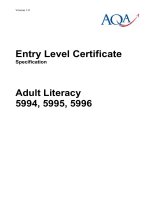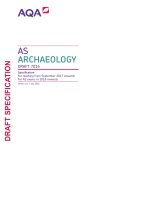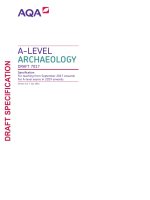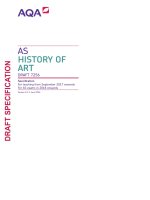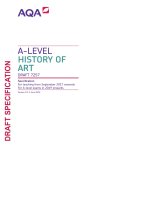AQA 7126 SP 2017
Bạn đang xem bản rút gọn của tài liệu. Xem và tải ngay bản đầy đủ của tài liệu tại đây (1.77 MB, 30 trang )
DRAFT 7126
T
Specification
For teaching from September 2017 onwards
For AS exams in 2018 onwards
R
AF
Version 0.1 7 July 2016
D
DRAFT SPECIFICATION
AS
ACCOUNTING
DRAFT SPECIFICATION
T
AF
R
D
AS Accounting DRAFT 7126. AS exams June 2018 onwards. Version 0.1 7 July 2016
Contents
1 Introduction
5
5
5
6
1.1 Why choose AQA for AS Accounting
1.2 Support and resources to help you teach
1.3 Draft specification
7
2.1 Subject content
2.2 Assessments
7
7
3 Subject Content
9
T
3.1 An introduction to the role of the accountant in
business
3.2 Types of business organisation
3.3 The double entry model
3.4 Verification of accounting records
3.5 Accounting concepts used in the preparation of
accounting records
3.6 Preparation of financial statements of sole traders
3.7 Limited company accounts
3.8 Analysis and evaluation of financial information
3.9 Budgeting
3.10 Marginal costing
9
9
10
12
AF
R
4 Scheme of assessment
D
DRAFT SPECIFICATION
2 Specification at a glance
4.1 Aims
4.2 Assessment objectives
4.3 Assessment weightings
5 General administration
5.1 Entries and codes
5.2 Overlaps with other qualifications
5.3 Awarding grades and reporting results
5.4 Re-sits and shelf life
5.5 Previous learning and prerequisites
5.6 Access to assessment: diversity and inclusion
5.7 Working with AQA for the first time
5.8 Private candidates
5.9 Use of calculators
6 Appendix: international terminology
12
13
14
14
15
15
17
17
17
18
19
19
19
19
19
20
20
20
21
21
25
Visit aqa.org.uk/7126 for the most up-to-date specification, resources, support and administration 3
7 Annex: skills in accounting
27
8 Annex: quantitative skills in accounting
Are you using the latest version of this specification?
•
•
You will always find the most up-to-date version of this specification on our website at
aqa.org.uk/7126
We will write to you if there are significant changes to the specification.
4 Visit aqa.org.uk/7126 for the most up-to-date specification, resources, support and administration
DRAFT SPECIFICATION
D
R
AF
T
29
AS Accounting DRAFT 7126. AS exams June 2018 onwards. Version 0.1 7 July 2016
1 Introduction
1.1 Why choose AQA for AS Accounting
Students will build knowledge and understanding of key concepts, principles and techniques that
they can apply to real-life scenarios, developing the ability to solve problems logically, analyse data
methodically, make reasoned choices and communicate effectively.
You can find out about all our Accounting qualifications at aqa.org.uk/accounting
A specification designed for you and your students
AF
T
We've created this specification with help from teachers and subject experts. You'll see that we've
kept the content that you and your students enjoy and added new areas to keep content fresh and
relevant. Students will gain core knowledge of financial and management accounting.
Clear, well-structured exams, accessible for all
R
To enable your students to show their breadth of knowledge and understanding, we've created a
simple and straightforward structure and layout for our paper, using a mixture of question types
including multiple choice, short answer and scenario based questions. Assessment remains 100%
exam-based.
For more information on our exciting new AS Accounting qualification, visit aqa.org.uk/accounting
1.2 Support and resources to help you teach
D
DRAFT SPECIFICATION
A qualification in accounting will always be helpful – whether it's used professionally or personally.
This course helps students to understand the responsibilities of the accountant and the impacts of
their recommendations on the business and the wider environment.
We’ve worked with experienced teachers to provide you with a range of resources that will help
you confidently plan, teach and prepare for exams.
Teaching resources
Visit aqa.org.uk/7126 to see all our teaching resources. They include:
•
•
•
•
•
sample schemes of work to help you plan your course with confidence
detailed teacher guides on new topics
marked exemplars with examiner commentary.
training courses to help you deliver AQA Accounting qualifications
subject expertise courses for all teachers, from newly-qualified teachers who are just getting
started to experienced teachers looking for fresh inspiration.
Preparing for exams
Visit aqa.org.uk/7126 for everything you need to prepare for our exams, including:
• past papers, mark schemes and examiners’ reports
Visit aqa.org.uk/7126 for the most up-to-date specification, resources, support and administration 5
• specimen papers and mark schemes for new courses
• Exampro: a searchable bank of past AQA exam questions
• exemplar student answers with examiner commentaries.
Analyse your students' results with Enhanced Results Analysis (ERA)
Find out which questions were the most challenging, how the results compare to previous years
and where your students need to improve. ERA, our free online results analysis tool, will help you
see where to focus your teaching. Register at aqa.org.uk/era
For information about results, including maintaining standards over time, grade boundaries and our
post-results services, visit aqa.org.uk/results
Wherever you are in your career, there’s always something new to learn. As well as subjectspecific training, we offer a range of courses to help boost your skills.
T
• Improve your teaching skills in areas including differentiation, teaching literacy and meeting
Ofsted requirements.
• Prepare for a new role with our leadership and management courses.
AF
You can attend a course at venues around the country, in your school or online – whatever suits
your needs and availability. Find out more at coursesandevents.aqa.org.uk
Help and support available
Visit our website for information, guidance, support and resources at aqa.org.uk/7126
R
If you'd like us to share news and information about this qualification, sign up for emails and
updates at aqa.org.uk/from-2017
Alternatively, you can call or email our subject team direct.
E:
D
T: 01483 477 863
1.3 Draft specification
This draft qualification has not yet been accredited by Ofqual. It is published to enable teachers to
have early sight of our proposed approach to AS Accounting. Further changes may be required
and no assurance can be given that this proposed qualification will be made available in its current
form, or that it will be accredited in time for first teaching in September 2017 and first award in
August 2019.
6 Visit aqa.org.uk/7126 for the most up-to-date specification, resources, support and administration
DRAFT SPECIFICATION
Keep your skills up-to-date with professional development
AS Accounting DRAFT 7126. AS exams June 2018 onwards. Version 0.1 7 July 2016
2 Specification at a glance
This qualification is linear. Linear means that students will sit all their exams at the end of the
course.
2.2 Assessments
Paper 1
R
What's assessed
AF
T
1. An introduction to the role of the accountant in business (page 9)
2. Types of business organisation (page 9)
3. The double entry model (page 10)
4. Verification of accounting records (page 12)
5. Accounting concepts used in the preparation of account records (page 12)
6. Preparation of financial statements of sole traders (page 13)
7. Limited company accounts (page 14)
8. Analysis and evaluation of financial information (page 14)
9. Budgeting (page 15)
10. Marginal costing (page 15)
Sections 1–10 of the subject content
How it's assessed
D
DRAFT SPECIFICATION
2.1 Subject content
• Written exam: 3 hours
• 120 marks
• 100% of AS
Questions
Three compulsory sections:
• Section A has 10 multiple choice questions and short answer questions. The section is worth
25 marks.
• Section B has four structured questions. The section is worth 55 marks.
• Section C has two extended answer questions each worth 20 marks. The section is worth 40
marks.
Visit aqa.org.uk/7126 for the most up-to-date specification, resources, support and administration 7
DRAFT SPECIFICATION
T
AF
R
D
8 Visit aqa.org.uk/7126 for the most up-to-date specification, resources, support and administration
AS Accounting DRAFT 7126. AS exams June 2018 onwards. Version 0.1 7 July 2016
3 Subject Content
Students will need to demonstrate a good understanding of the double entry model and accounting
principles and concepts as these form the foundation of all financial accounting techniques. They
will also need to demonstrate quantitative skills that are relevant to the subject. Students will be
expected to demonstrate knowledge of the formulae used for computations, carrying out
computations and use the results of computations to inform judgements, solve problems and make
decisions. It is also important that students focus on developing their ability to write effectively so
that they can report to stakeholders, making logical arguments and providing sound judgements
based on an analysis of available evidence taking account of financial and non-financial factors.
Content
AF
T
3.1 An introduction to the role of the accountant in
business
Additional information
R
The responsibilities of the accountant within
business.
The difference between financial accounting and
management accounting and the purpose of
each.
D
DRAFT SPECIFICATION
The specification emphasises both financial accounting and the recording of past events, and
management accounting as a means of planning and decision making. Students should appreciate
that these are not totally distinct areas of study and that there is an interrelationship between
financial accounting and aspects of management accounting.
The role of the accountant includes overseeing
The role of the accountant in developing and
the work of bookkeepers and ledger clerks.
overseeing accounting information systems to
provide reliable and relevant information for both
financial and management purposes.
3.2 Types of business organisation
Content
Additional information
Types of business organisations including
different business ownership models.
Business organisations are: sole traders,
partnerships, private (Ltd) and public limited
liability companies (plc).
The associated benefits and risks and the
impact on business reporting.
Visit aqa.org.uk/7126 for the most up-to-date specification, resources, support and administration 9
Content
Additional information
Sources of finance for different forms of
business organisation and the risks related to
those.
Sources of finance are: owner’s capital,
partners’ capital, bank overdraft, bank loan,
mortgage, ordinary shares, debentures.
Content
Additional information
The double entry system including the
recording of transactions from source
documents in books of prime entry and
ledger accounts, transferring accounts to
income statements, balancing accounts
and the preparation of statements of
financial position.
Source documents are:
T
purchase invoices
sales invoices
credit notes
cheque counterfoils
till rolls
cash receipts
paying-in slip counterfoils
bank statements (for standing orders, direct
debits, credit transfers, dishonoured cheques,
debit card transactions, direct transfers).
AF
•
•
•
•
•
•
•
•
Books of prime entry are:
D
R
•
•
•
•
•
purchases journal
sales journal
returns journals
general journal
three column cash book.
Ledger accounts may be subdivided into:
• receivables ledger
• payables ledger
• general ledger accounts.
Transactions could be for service or trading
businesses and, as well as those arising from the
documents listed above, could include:
•
•
•
•
trade and cash discounts
disposal of non-current assets
irrecoverable debts
contra entries between accounts of credit
customers and credit suppliers.
The distinction between revenue expenditure and
capital expenditure, and revenue income and capital
income.
10 Visit aqa.org.uk/7126 for the most up-to-date specification, resources, support and administration
DRAFT SPECIFICATION
3.3 The double entry model
Content
Additional information
The recording of adjustments in ledger
accounts and financial statements.
Adjustments are:
•
•
•
•
•
•
•
•
accruals
prepayments
income due
income received in advance
provisions for doubtful debts
depreciation charges
disposal of non-current assets
opening and closing inventory.
Prepare and understand accounting
records based on source documents and
use the main books of prime entry and
ledger accounts.
AF
T
Apply the double entry model in the
preparation of financial statements for a
range of business organisations.
Prepare income statements (trading and
profit and loss accounts) and statements
of financial position (balance sheets)
working from trial balances and additional
information.
Financial statements could be for:
Prepare statements of financial position
(balance sheets) with subheadings.
Subheadings in a statement of financial position are:
• service businesses
• trading businesses.
R
D
DRAFT SPECIFICATION
AS Accounting DRAFT 7126. AS exams June 2018 onwards. Version 0.1 7 July 2016
•
•
•
•
•
non-current assets
current assets
capital (equity)
non-current liabilities
current liabilities.
Note: manufacturing accounts will not be examined.
Make entries for simple adjustments for
expense prepayments and accruals in
ledger accounts and in income statements
and statements of financial position.
Make entries for irrecoverable debts in the Entries could include those for the recovery of
sales ledger and financial statements.
irrecoverable debts.
Make entries for depreciation in the
income statement and statement of
financial position.
Depreciation methods are:
• straight line method
• reducing balance method.
Visit aqa.org.uk/7126 for the most up-to-date specification, resources, support and administration 11
3.4 Verification of accounting records
Content
Additional information
Verification of the double entry records.
Verification techniques are: trial balance, bank
reconciliation statements, sales ledger control
accounts, purchases ledger control accounts.
•
•
•
•
Correcting errors includes the use of the general
journal and suspense account.
T
How to correct errors in double entry
records.
contra entries
interest charged on overdue accounts
debit balances in purchases ledger
credit balances in sales ledger.
AF
Errors could include those revealed by a trial
balance as well as those that are not revealed.
The effect of errors on profit calculations and The effect of errors includes the redrafting of
financial statements to correct errors.
statements of financial position.
The benefits and limitations may include identifying
errors that are revealed and those that are not
revealed by the relevant verification technique.
R
The benefits and limitations of verification
techniques.
Content
D
3.5 Accounting concepts used in the preparation of
accounting records
General accounting concepts.
Additional information
Concepts are:
•
•
•
•
•
•
•
•
•
•
money measurement
duality
cost
going concern
accruals
consistency
prudence
materiality
realisation
business entity.
12 Visit aqa.org.uk/7126 for the most up-to-date specification, resources, support and administration
DRAFT SPECIFICATION
Control accounts could include the following in
addition to transactions stated or implied
elsewhere:
AS Accounting DRAFT 7126. AS exams June 2018 onwards. Version 0.1 7 July 2016
Content
Additional information
The use of accounting concepts in a
variety of situations.
Situations are:
•
•
•
•
preparation of financial statements
asset valuation
depreciation of non-current assets
inventories (using cost or net realisable value as
the basis for valuation).
Content
Additional information
The use of concepts in the preparation of
financial statements.
The use of concepts will result in recording:
AF
T
• accruals and prepayments
• depreciation (using straight line and reducing
balance methods)
• disposal of non-current assets
• provision for doubtful debts
• irrecoverable debts
• recovery of irrecoverable debts
• income due
• income received in advance
• goods taken for own use
• goods on sale or return
• inventory.
R
D
DRAFT SPECIFICATION
3.6 Preparation of financial statements of sole traders
Note: first in, first out (FIFO), average cost (AVCO)
and last in, first out (LIFO) methods of inventory
valuation will not be examined.
How to prepare financial statements of
Sole traders’ financial statements could be for:
sole traders from ledger accounts
• service businesses
including adjustments from the application
• trading businesses.
of accounting concepts.
Preparation of financial statements could include the
recording of adjustments and items listed above in
ledger accounts.
How to prepare income statements and
statements of financial position from a trial
balance including adjustments from the
application of accounting concepts.
Visit aqa.org.uk/7126 for the most up-to-date specification, resources, support and administration 13
3.7 Limited company accounts
Content
Additional information
How to prepare the internal financial
statements of private limited liability
companies including income statements,
statements of changes in equity and
statements of financial position.
Statement of changes in equity could include
entries for:
opening balances
share issues including those made at a premium
dividends paid
profit (or loss) for the year
closing balances.
The income statement should include the distinction
between:
T
• profit from operations
• profit for the year before tax
• profit for the year after tax.
AF
Note: preference shares and general reserves will
not be examined.
3.8 Analysis and evaluation of financial information
Content
Additional information
Financial ratios and measures are:
D
R
Calculation and interpretation of financial
measures and ratios.
Appraising business performance by using
financial statements and ratios.
•
•
•
•
•
•
•
•
•
•
•
•
gross profit margin %
markup %
rate of inventory turnover
rate of inventory turnover (days)
profit in relation to revenue %
expenses in relation to revenue %
return on capital employed %
current ratio
liquid capital ratio
trade receivable days
trade payable days
capital gearing.
Appraisals could focus on:
•
•
•
•
profitability
liquidity
efficiency
capital structure.
14 Visit aqa.org.uk/7126 for the most up-to-date specification, resources, support and administration
DRAFT SPECIFICATION
•
•
•
•
•
AS Accounting DRAFT 7126. AS exams June 2018 onwards. Version 0.1 7 July 2016
Content
Additional information
The difference between cash and profits
and the effect of transactions on profitability
and liquidity.
The limitations of financial statements and
ratio analysis when assessing business
performance.
Additional information
The need for budgeting in business
organisations.
The purpose of budgeting.
The benefits and limitations of budgeting
and budgetary control.
Benefits and limitations could include consideration
of:
T
Content
AF
• zero-based budgeting
• incremental budgeting.
The budgets are:
• financial statements: income statement
• financial statements: statements of financial
position.
R
The use of accounting techniques in the
preparation and analysis of budgets.
How budgets are used in planning and
control and the calculation and
interpretation of variances.
D
DRAFT SPECIFICATION
3.9 Budgeting
3.10 Marginal costing
Content
Additional information
Categorisation of costs by behaviour and
understanding of terms.
Costs and terms are:
•
•
•
•
•
•
•
•
•
direct costs
indirect costs
variable costs
semi-variable costs
fixed costs
stepped costs
marginal cost
contribution
break-even.
Visit aqa.org.uk/7126 for the most up-to-date specification, resources, support and administration 15
Content
Additional information
Calculation and interpretation of break-even Break-even analysis methods are break-even
point, interpreting break-even charts and the calculations and break-even charts.
uses and limitations of break-even analysis
methods.
make or buy
acceptance of additional work
price setting
optimum use of scarce resources
closing of potentially loss-making line or
production department
• target profit.
•
•
•
•
•
AF
R
D
16 Visit aqa.org.uk/7126 for the most up-to-date specification, resources, support and administration
DRAFT SPECIFICATION
Decision making situations are:
T
The use of marginal costing in decision
making situations.
AS Accounting DRAFT 7126. AS exams June 2018 onwards. Version 0.1 7 July 2016
4 Scheme of assessment
Find past papers and mark schemes, and specimen papers for new courses, on our website at
aqa.org.uk/pastpapers
This specification is designed to be taken over one or two years.
This is a linear qualification. In order to achieve the award, students must complete all
assessments at the end of the course and in the same series.
All materials are available in English only.
Our AS exams in Accounting include questions that allow students to demonstrate their ability to:
AF
4.1 Aims
T
• provide extended responses
• draw together their knowledge, skills and understanding from across the full course of study.
Courses based on this specification should encourage students to:
R
• understand the role and develop the skills of the accountant in developing and evaluating
accounting information systems and in preparing financial and management accounting
information
• apply the principles and techniques of accounting in the preparation of financial and
management accounting information including using the double entry model to: record
transactions; prepare financial statements for different types of organisations; and prepare
management accounting information to enable management to plan, control and make
decisions
• analyse and evaluate a range of financial and management information and communicate the
outcomes numerically and verbally
• develop the ability to solve problems logically, analyse data methodically, make reasoned and
justified decisions and use different reporting methods to communicate these to stakeholders.
D
DRAFT SPECIFICATION
AS exams and certification for this specification are available for the first time in May/June 2018
and then every May/June for the life of the specification.
4.2 Assessment objectives
Assessment objectives (AOs) are set by Ofqual and are the same across all AS Accounting
specifications and all exam boards.
The exams will measure how students have achieved the following assessment objectives.
• AO1: Demonstrate knowledge and understanding of accounting principles, concepts and
techniques.
• AO2: Apply knowledge and understanding of accounting principles, concepts and techniques.
• AO3: Analyse and evaluate accounting data to present information, make judgements and draw
conclusions.
Visit aqa.org.uk/7126 for the most up-to-date specification, resources, support and administration 17
Assessment objective weightings for AS Accounting
Assessment objectives (AOs)
Component
weightings (approx
%)
Overall weighting
(approx %)
AO1
32–34
32–34
AO2
41–43
41–43
AO3
25–27
25–27
Overall weighting of components
100
100
4.3 Assessment weightings
Maximum raw mark
Paper 1
120
Scaling factor
AF
Component
T
The marks awarded on the papers will be scaled to meet the weighting of the components.
Students’ final marks will be calculated by adding together the scaled marks for each component.
Grade boundaries will be set using this total scaled mark. The scaling and total scaled marks are
shown in the table below.
x1
Maximum scaled mark
120
D
R
Total scaled mark: 120
18 Visit aqa.org.uk/7126 for the most up-to-date specification, resources, support and administration
DRAFT SPECIFICATION
Paper 1
AS Accounting DRAFT 7126. AS exams June 2018 onwards. Version 0.1 7 July 2016
5 General administration
You can find information about all aspects of administration, as well as all the forms you need, at
aqa.org.uk/examsadmin
5.1 Entries and codes
Every specification is given a national discount (classification) code by the Department for
Education (DfE), which indicates its subject area.
Qualification title
AQA entry code
DfE discount code
7126
XXX
AF
AQA Advanced Subsidiary GCE in Accounting
T
If a student takes two specifications with the same discount code, further and higher education
providers are likely to take the view that they have only achieved one of the two qualifications.
Please check this before your students start their course.
This specification complies with:
Ofqual General conditions of recognition that apply to all regulated qualifications
Ofqual GCE qualification level conditions that apply to all GCEs
Ofqual GCE subject level conditions that apply to all GCEs in this subject
all other relevant regulatory documents.
R
•
•
•
•
The Ofqual qualification accreditation number (QAN) is TBC.
5.2 Overlaps with other qualifications
D
DRAFT SPECIFICATION
You only need to make one entry for each qualification – this will cover all the question papers,
non-exam assessment and certification.
There is overlapping content in the AS and A-level Accounting specifications. This helps you teach
the AS and A-level together.
5.3 Awarding grades and reporting results
The AS qualification will be graded on a five-point scale: A, B, C, D and E.
Students who fail to reach the minimum standard for grade E will be recorded as U (unclassified)
and will not receive a qualification certificate.
5.4 Re-sits and shelf life
Students can re-sit the qualification as many times as they wish, within the shelf life of the
qualification.
Visit aqa.org.uk/7126 for the most up-to-date specification, resources, support and administration 19
5.5 Previous learning and prerequisites
There are no previous learning requirements. Any requirements for entry to a course based on this
specification are at the discretion of schools and colleges.
5.6 Access to assessment: diversity and inclusion
The subject criteria have been assessed to see if any of the skills or knowledge required present
any possible difficulty to any students, whatever their ethnic background, religion, sex, age,
disability or sexuality. If any difficulties were encountered, the criteria were reviewed again to make
sure that tests of specific competences were only included if they were important to the subject.
T
As members of the Joint Council for Qualifications (JCQ) we participate in the production of the
JCQ document Access Arrangements and Reasonable Adjustments: General and Vocational
qualifications. We follow these guidelines when assessing the needs of individual students who
may require an access arrangement or reasonable adjustment. This document is published on the
JCQ website at jcq.org.uk
AF
5.6.1 Students with disabilities and special needs
We can make arrangements for disabled students and students with special needs to help them
access the assessments, as long as the competences being tested are not changed. Access
arrangements must be agreed before the assessment. For example, a Braille paper would be a
reasonable adjustment for a Braille reader but not for a student who does not read Braille.
R
We are required by the Equality Act 2010 to make reasonable adjustments to remove or lessen
any disadvantage that affects a disabled student.
D
If you have students who need access arrangements or reasonable adjustments, you can apply
using the Access arrangements online service at aqa.org.uk/eaqa
5.6.2 Special consideration
We can give special consideration to students who have been disadvantaged at the time of the
assessment through no fault of their own – for example a temporary illness, injury or serious
problem such as the death of a relative. We can only do this after the assessment.
Your exams officer should apply online for special consideration at aqa.org.uk/eaqa
For more information and advice about access arrangements, reasonable adjustments and special
consideration please see aqa.org.uk/access or email
5.7 Working with AQA for the first time
If your school or college has not previously offered any AQA specification, you need to register as
an AQA centre to offer our specifications to your students. Find out how at aqa.org.uk/
becomeacentre
20 Visit aqa.org.uk/7126 for the most up-to-date specification, resources, support and administration
DRAFT SPECIFICATION
General qualifications are designed to prepare students for a wide range of occupations and
further study. Therefore our qualifications must assess a wide range of competences.
AS Accounting DRAFT 7126. AS exams June 2018 onwards. Version 0.1 7 July 2016
5.8 Private candidates
This specification is available to private candidates.
A private candidate is someone who enters for exams through an AQA-approved school or college
but is not enrolled as a student there.
A private candidate may be self-taught, home-schooled or have private tuition, either with a tutor or
through a distance learning organisation. You must be based in the UK.
• speak to the exams officer at the school or college where you intend to take your exams
• visit our website at aqa.org.uk/privatecandidates
• email:
5.9 Use of calculators
R
AF
T
Students must use a calculator in the exam. They must ensure that their calculator meets the
requirements as set out in the JCQ Instructions for conducting examinations. These instructions
make it clear what the requirements are for calculators (what they must be) and what they are not
(what they must not be). The instructions are regularly updated and can be found at jcq.org.uk.
D
DRAFT SPECIFICATION
If you have any queries as a private candidate, you can:
Visit aqa.org.uk/7126 for the most up-to-date specification, resources, support and administration 21
DRAFT SPECIFICATION
T
AF
R
D
22 Visit aqa.org.uk/7126 for the most up-to-date specification, resources, support and administration
AS Accounting DRAFT 7126. AS exams June 2018 onwards. Version 0.1 7 July 2016
Appendix: accounting ratios
Ratio
Formula
Capital gearing
Non-current liabilities
Issued share capital + Reserves + Non-current liabilities x
Current ratio
Current assets
Current liabilities
100
Expressed as x:1
Expenses in
relation to
revenue
Expenses
Revenue
Gross profit
margin
Gross profit
Revenue
Liquid capital
ratio (acid test
ratio)
Current assets - inventory
Current liabilities
T
x 100
AF
x 100
Expressed as x:1
Markup
Gross profit
Cost of sales
Profit in
relation to
revenue
Profit for year (before tax)
Revenue
Rate of
inventory
turnover
R
x 100
x 100
D
DRAFT SPECIFICATION
Students will be required to know the formulae for the following accounting ratios.
Rate of
inventory
turnover (days)
Cost of sales
Average inventory
Average inventory: normally the average of the opening and closing inventories.
Average inventory
Cost of sales
x 365
Profit before interest
Return on
Capital employed x 100
capital
employed (sole Capital employed is capital + non-current liabilities (either opening or closing
capital could be used in the calculation).
trader)
Return on
capital
employed
(limited
company)
Profit from operations
Capital employed
x 100
Capital employed is Equity + non-current liabilities (either opening or closing
figure for equity could be used in the calculation).
Visit aqa.org.uk/7126 for the most up-to-date specification, resources, support and administration 23
Trade payable
days
Trade payables
Credit purchases
Trade
receivable
days
Trade receivables
Credit sales
x 365
x 365
AF
R
D
24 Visit aqa.org.uk/7126 for the most up-to-date specification, resources, support and administration
DRAFT SPECIFICATION
Formula
T
Ratio
AS Accounting DRAFT 7126. AS exams June 2018 onwards. Version 0.1 7 July 2016
6 Appendix: international
terminology
International terminology
Terminology used previously
Financial statements
Final accounts and balance sheets
Income statement
Trading and profit and loss account
Inventory
Stock
Irrecoverable debt
Bad debt
Loss for year
Net loss
T
Financial statements
Non-current assets
Fixed assets
Long-term liabilities
AF
Non-current liabilities
Other payables
Expenses due; income received in advance
Other receivables
Expenses prepaid; income due
Profit for year
Net profit
R
Revenue (within an income statement)
Sales
Statement of financial position
Balance sheet
Trade payables
Trade creditors (creditors)
Trade receivables
D
DRAFT SPECIFICATION
Cash and cash equivalents (limited companies) Cash in hand, cash at bank/bank overdraft
Trade debtors (debtors)
Accounting ratios
Expenses in relation to revenue %
Expenses in relation to sales %
Profit to revenue %
Net profit to sales %
Rate of inventory turnover
Rate of stock turnover
Trade payable days
Creditor payment period
Trade receivable days
Debtor collection period
Visit aqa.org.uk/7126 for the most up-to-date specification, resources, support and administration 25




